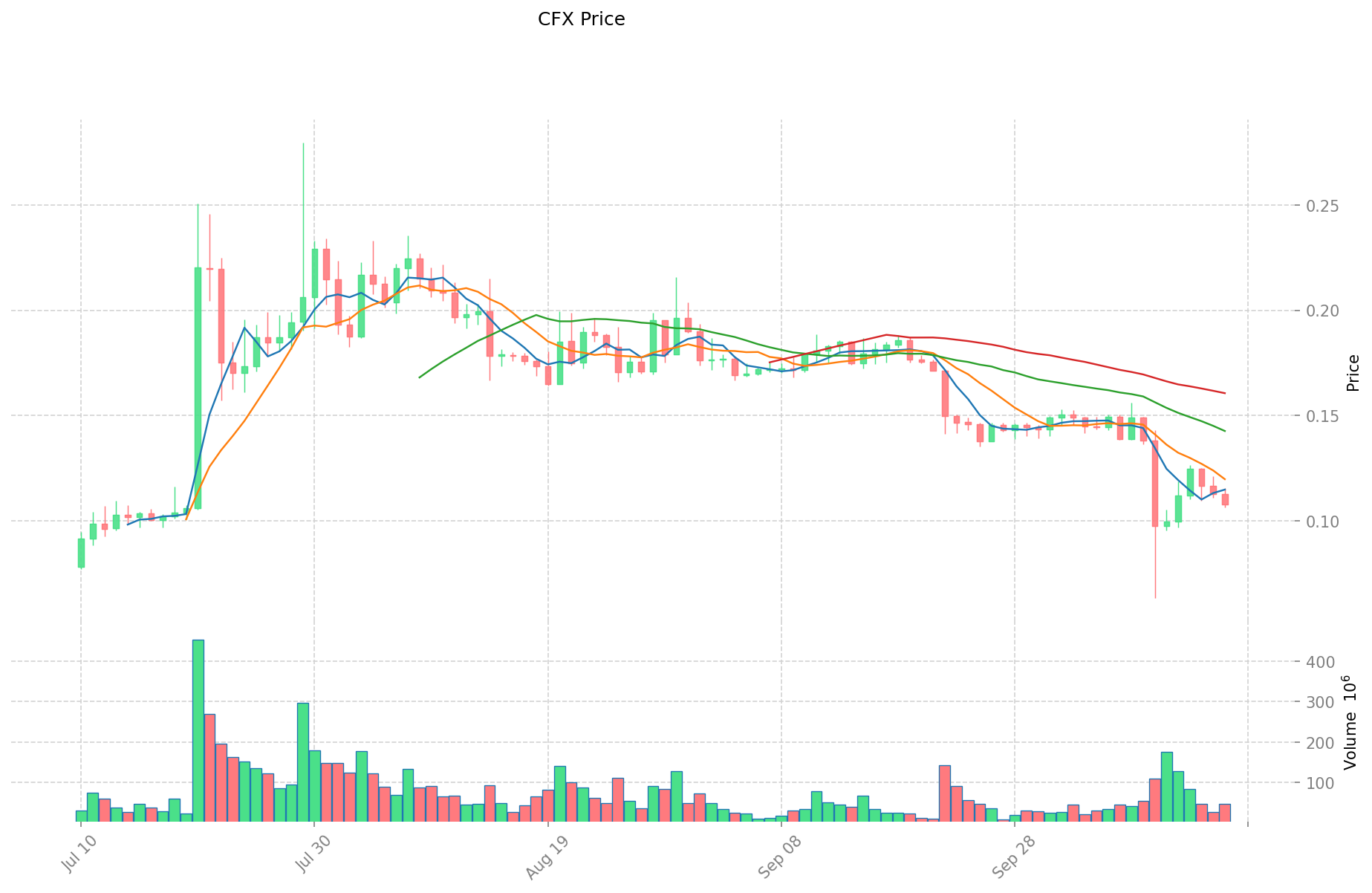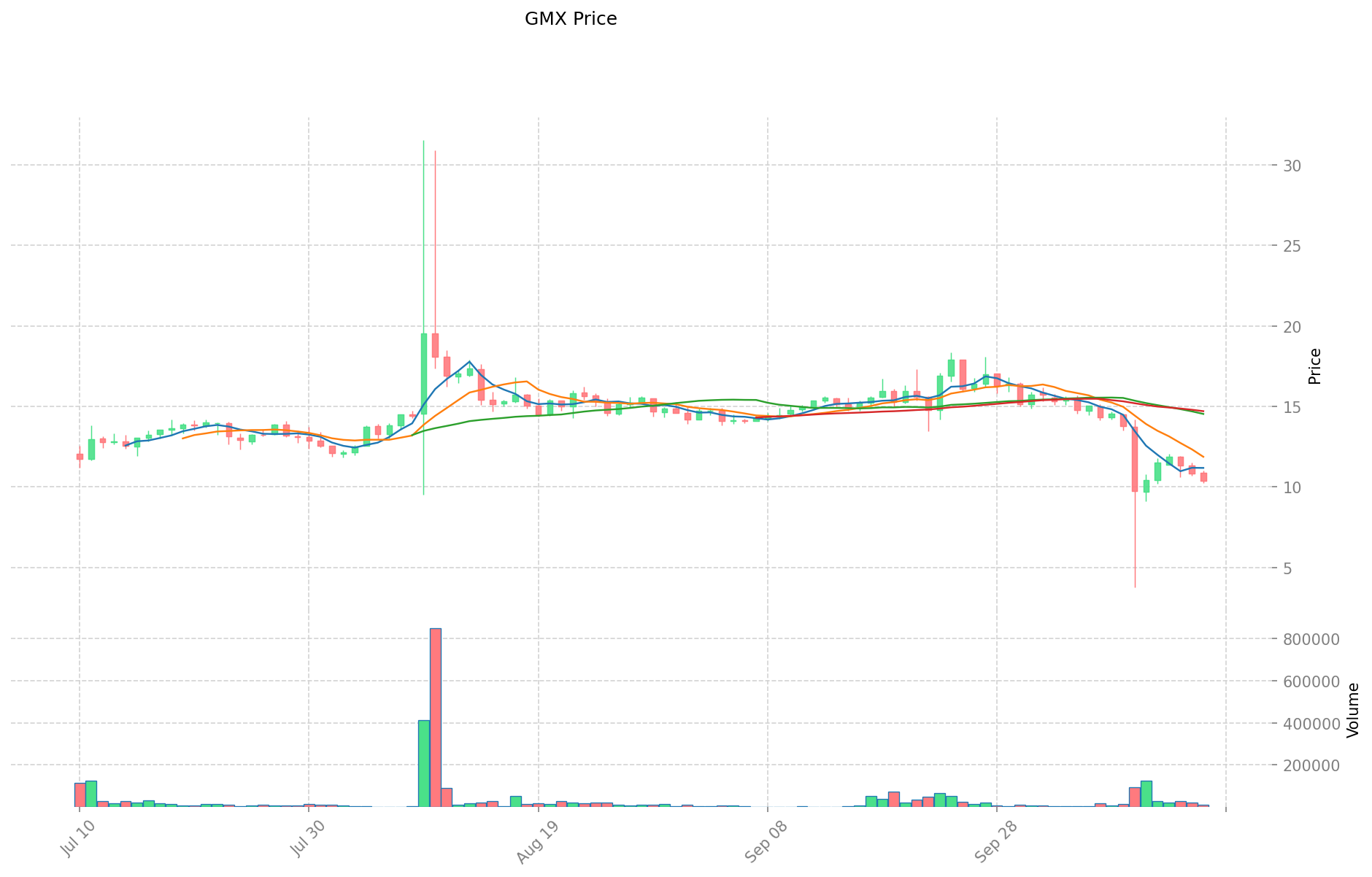CFX vs GMX: A Comparative Analysis of Two Leading Cryptocurrency Exchanges
Introduction: CFX vs GMX Investment Comparison
In the cryptocurrency market, the comparison between Conflux (CFX) and GMX (GMX) has always been a topic that investors cannot ignore. The two not only have significant differences in market cap ranking, application scenarios, and price performance, but also represent different positioning in the crypto asset space.
Conflux (CFX): Since its launch, it has gained market recognition for its scalable decentralized blockchain network designed to achieve high throughput and fast confirmation.
GMX (GMX): Established as a decentralized perpetual exchange, it has been recognized for its utility and governance token that also accrues 30% of the platform's generated fees.
This article will provide a comprehensive analysis of the investment value comparison between CFX and GMX, focusing on historical price trends, supply mechanisms, institutional adoption, technological ecosystems, and future predictions, attempting to answer the question most important to investors:
"Which is the better buy right now?"
I. Price History Comparison and Current Market Status
Conflux (CFX) and GMX Historical Price Trends
- 2023: CFX price surged due to increased adoption in China, reaching an all-time high of $1.70.
- 2023: GMX experienced significant growth, with its price peaking at $91.07 in April.
- Comparative analysis: During the 2023-2025 market cycle, CFX dropped from its high of $1.70 to a low of $0.02, while GMX showed more resilience, falling from $91.07 to a low of $6.92.
Current Market Situation (2025-10-17)
- CFX current price: $0.10739
- GMX current price: $10.34
- 24-hour trading volume: CFX $5,276,085 vs GMX $113,612
- Market Sentiment Index (Fear & Greed Index): 28 (Fear)
Click to view real-time prices:
- View CFX current price Market Price
- View GMX current price Market Price


II. Core Factors Affecting CFX vs GMX Investment Value
Supply Mechanisms (Tokenomics)
- GMX: Utilizes a unique liquidity pool model that incorporates multiple assets, enhancing capital efficiency while reducing friction
- Pear Protocol: Integrates with GMX and offers the $PEAR token with specific allocation: 0.51% public sale, 20% private sale, 30.49% treasury, and 17.07% team
- 📌 Historical Pattern: The innovative liquidity mechanisms drive price cycle changes through improved capital efficiency.
Institutional Adoption & Market Applications
- Institutional Holdings: GMX has gained popularity on Arbitrum network, becoming one of the most popular dApps in the derivatives space
- Enterprise Adoption: GMX's integration with Pear Protocol enables paired trading functionality across various blockchain trading engines
- Regulatory Attitudes: Pear Protocol aims to operate in a decentralized manner through DAO governance by $PEAR token holders
Technical Development & Ecosystem Building
- GMX Technical Features: Offers cost-effective risk hedging tools with its multi-asset liquidity model
- Pear Protocol Development: Integrates three different trading engines (GMX, Vertex, SYMMIO) for isolated, cross-margin, and intent-based order types
- Ecosystem Comparison: Pear Protocol enhances DeFi composability by marking each position as NFT, enabling sub-accounts and social trading through wallet transfers and NFT marketplaces
Macroeconomic & Market Cycles
- Performance in Inflationary Environments: Pear Protocol allows traders to effectively manage risk through various strategies based on market conditions
- Monetary Policy Effects: Beta coefficient analysis helps traders understand how assets respond to broader market movements
- Cross-Border Transaction Demand: Pear Protocol will initially deploy on Arbitrum with potential for multi-chain support in the future
III. 2025-2030 Price Prediction: CFX vs GMX
Short-term Prediction (2025)
- CFX: Conservative $0.0584-$0.1082 | Optimistic $0.1082-$0.1558
- GMX: Conservative $9.0654-$10.42 | Optimistic $10.42-$14.7964
Mid-term Prediction (2027)
- CFX may enter a growth phase, with prices estimated between $0.1162-$0.1800
- GMX may enter a steady growth phase, with prices estimated between $11.3051-$16.5999
- Key drivers: Institutional capital inflow, ETF developments, ecosystem growth
Long-term Prediction (2030)
- CFX: Base scenario $0.1870-$0.2398 | Optimistic scenario $0.2398-$0.2734
- GMX: Base scenario $12.7598-$19.9371 | Optimistic scenario $19.9371-$24.7220
Disclaimer: The above predictions are based on historical data and market analysis. Cryptocurrency markets are highly volatile and subject to change. This information should not be considered as financial advice. Always conduct your own research before making investment decisions.
CFX:
| 年份 | 预测最高价 | 预测平均价格 | 预测最低价 | 涨跌幅 |
|---|---|---|---|---|
| 2025 | 0.1557648 | 0.10817 | 0.0584118 | 0 |
| 2026 | 0.195311752 | 0.1319674 | 0.076541092 | 22 |
| 2027 | 0.1800035336 | 0.163639576 | 0.11618409896 | 52 |
| 2028 | 0.252577685556 | 0.1718215548 | 0.161512261512 | 59 |
| 2029 | 0.26737152142428 | 0.212199620178 | 0.13156376451036 | 97 |
| 2030 | 0.273355550713299 | 0.23978557080114 | 0.187032745224889 | 123 |
GMX:
| 年份 | 预测最高价 | 预测平均价格 | 预测最低价 | 涨跌幅 |
|---|---|---|---|---|
| 2025 | 14.7964 | 10.42 | 9.0654 | 0 |
| 2026 | 16.012414 | 12.6082 | 10.08656 | 21 |
| 2027 | 16.59995612 | 14.310307 | 11.30514253 | 38 |
| 2028 | 17.773401294 | 15.45513156 | 9.273078936 | 49 |
| 2029 | 23.2599729978 | 16.614266427 | 12.29455715598 | 60 |
| 2030 | 24.722028443376 | 19.9371197124 | 12.759756615936 | 92 |
IV. Investment Strategy Comparison: CFX vs GMX
Long-term vs Short-term Investment Strategies
- CFX: Suitable for investors focused on scalable blockchain networks and potential growth in the Chinese market
- GMX: Suitable for investors interested in decentralized perpetual exchanges and fee-sharing mechanisms
Risk Management and Asset Allocation
- Conservative investors: CFX: 30% vs GMX: 70%
- Aggressive investors: CFX: 60% vs GMX: 40%
- Hedging tools: Stablecoin allocation, options, cross-currency combinations
V. Potential Risk Comparison
Market Risks
- CFX: High volatility, susceptibility to regulatory changes in China
- GMX: Dependency on DeFi market trends, competition from other decentralized exchanges
Technical Risks
- CFX: Scalability, network stability
- GMX: Smart contract vulnerabilities, liquidity pool imbalances
Regulatory Risks
- Global regulatory policies may have different impacts on CFX and GMX, with CFX potentially facing more scrutiny due to its connections with the Chinese market
VI. Conclusion: Which Is the Better Buy?
📌 Investment Value Summary:
- CFX advantages: Scalable blockchain network, potential for growth in the Chinese market
- GMX advantages: Established decentralized perpetual exchange, fee-sharing mechanism, integration with innovative protocols like Pear
✅ Investment Advice:
- New investors: Consider a balanced approach with a slight preference for GMX due to its more established position in the DeFi space
- Experienced investors: Explore opportunities in both CFX and GMX, adjusting allocation based on risk tolerance and market trends
- Institutional investors: Consider GMX for its potential in the growing decentralized derivatives market, while monitoring CFX for long-term blockchain infrastructure plays
⚠️ Risk Warning: The cryptocurrency market is highly volatile, and this article does not constitute investment advice. None
VII. FAQ
Q1: What are the main differences between CFX and GMX? A: CFX is a scalable blockchain network focused on high throughput, while GMX is a decentralized perpetual exchange with a fee-sharing mechanism. CFX has potential growth in the Chinese market, while GMX is established in the DeFi space.
Q2: Which coin has shown better price stability? A: Based on historical data, GMX has shown more price resilience compared to CFX. During the 2023-2025 market cycle, CFX dropped from $1.70 to $0.02, while GMX fell from $91.07 to $6.92.
Q3: How do the supply mechanisms differ between CFX and GMX? A: GMX utilizes a unique liquidity pool model incorporating multiple assets, enhancing capital efficiency. CFX's specific tokenomics were not detailed in the provided information.
Q4: What are the key factors affecting the investment value of CFX and GMX? A: Key factors include supply mechanisms, institutional adoption, market applications, technical development, ecosystem building, and macroeconomic conditions.
Q5: What are the long-term price predictions for CFX and GMX by 2030? A: For CFX, the base scenario predicts $0.1870-$0.2398, with an optimistic scenario of $0.2398-$0.2734. For GMX, the base scenario predicts $12.7598-$19.9371, with an optimistic scenario of $19.9371-$24.7220.
Q6: How should investors allocate their assets between CFX and GMX? A: Conservative investors might consider 30% CFX and 70% GMX, while aggressive investors might opt for 60% CFX and 40% GMX. However, individual allocation should be based on personal risk tolerance and market analysis.
Q7: What are the main risks associated with investing in CFX and GMX? A: Both face market risks such as volatility. CFX may be more susceptible to regulatory changes in China, while GMX faces risks related to DeFi market trends and competition. Technical risks include scalability issues for CFX and smart contract vulnerabilities for GMX.
Share
Content